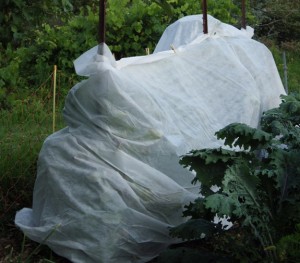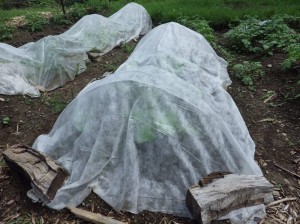 Now, I would not necessarily say that you can make pickles out of anything, but considering the fact that you can make pickles out of watermelon rind and zucchini, I think it’s not a real stretch to say so. At this point in the gardening season, the veggies out there are pumping out amazing amounts of stuff and there is no way for us to keep up with eating it fresh, so here at Chez Siberia, we tend to freeze and can (or, more technically speaking, jar) things when they are at their best. Today’s been busy – the DH and I have already done up zucchini bread and butter pickles
Now, I would not necessarily say that you can make pickles out of anything, but considering the fact that you can make pickles out of watermelon rind and zucchini, I think it’s not a real stretch to say so. At this point in the gardening season, the veggies out there are pumping out amazing amounts of stuff and there is no way for us to keep up with eating it fresh, so here at Chez Siberia, we tend to freeze and can (or, more technically speaking, jar) things when they are at their best. Today’s been busy – the DH and I have already done up zucchini bread and butter pickles
zucchini pickles
and were left with a dutch oven full of the pickling liquid.
The DH, not one to allow good pickling liquid to go wanting a use, ran out to the garden, and came back thirty minutes later with a huge bag of green beans with the suggestion that we pickle those too.
oooookay. Far be it from me to argue about this because although I LOVE fresh green beans from the garden, we have never had good luck with freezing them (I think they have the texture and taste of paper towels, frankly) and I think I have at least a dozen big jars of beans that we canned a very long time ago (and they are fine – the seals are intact, no bulges, leaking, etc. No discoloration and the cloves of garlic in the jars look perfect) which sit, lonely, in the dark of the pickle cellar downstairs. So, it’s obvious to ME that no one is going crazy for canned green beans.
But green bean pickles? Hmmmmm, that might be a winner and I’m certainly willing to try.
This is as much of an experiment as anything else but here is what we did and we’ll see how they come out.
For a big bowl of beans, washed, tops and tails trimmed and sliced on the diagonal (because I dote on diagonals):
Sprinkle 1/2 cup of canning or coarse salt and mix thoroughly, cover with ice and cover the bowl and allow to sit for three hours. Then rinse thoroughly three times.
Meanwhile, wash several canning jars and put into an oven preheated to 200 degrees F until hot. Put matching sized lids and rings into water in a saucepan and heat until simmering. Turn the heat off.
Put into a big pot (like, dutch oven sized):
3 cups of white vinegar
3 cups of white sugar
2 tsp. celery seed
2 tsp. mustard seed
1 1/2 tsp. turmeric
1 tsp. dried ground ginger
1/2 tsp. ground black pepper
Once you’ve rinsed the beans, bring the pickling liquid to a boil, throw in the beans and reduce heat. When it comes back to a simmer, keep it at a simmer for 2 minutes. While it’s simmering, get your funnel, spoon etc. ready.
Ladle the beans into the hot jars to within 1/4 inch of the top edge. Clean off the edge with a clean, wet paper towel, and then put on a lid and band and tighten down. Process the way you do all other pickles (water bath for 5 min. or whatever is your favorite method).
We’ll report back on how these turn out.
Bon appetit!!
 It’s not a secret to anyone, I think, that I love taking workshops. Learning new stuff is something that I dearly love to do. But over the years, I’ve come to realize that there are really several different sorts of workshops and of course people have all different sorts of reasons why they are taking them. Here are a few important things to remember when researching workshops to learn something specific. My most recent workshop was in woodworking but I think these are worthwhile when you are looking for any sort of workshop.
It’s not a secret to anyone, I think, that I love taking workshops. Learning new stuff is something that I dearly love to do. But over the years, I’ve come to realize that there are really several different sorts of workshops and of course people have all different sorts of reasons why they are taking them. Here are a few important things to remember when researching workshops to learn something specific. My most recent workshop was in woodworking but I think these are worthwhile when you are looking for any sort of workshop.













